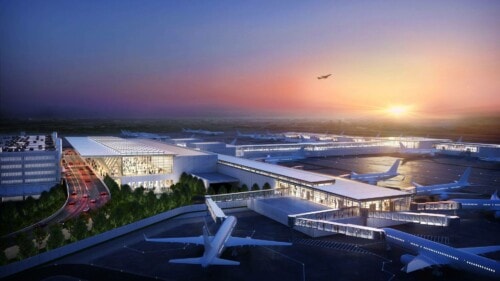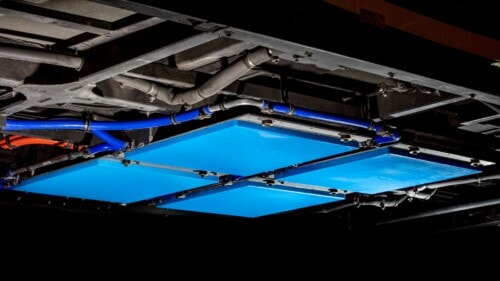Plan for Biggest US Airport Solar Energy Farm Expected to Land Soon at KCI 'An astronomical amount of green energy'
Published October 25th, 2022 at 6:00 AM
Above image credit: An illustration of a proposed solar farm at Kansas City International Airport. (Courtesy | Kansas City Aviation Department)Big news about an unprecedented municipal solar farm investment at Kansas City International Airport that would make national headlines – and surprise and delight Kansas Citians – is expected in early 2023.
Kansas City City Manager Brian Platt said that the city’s request for proposals for the construction of a swath of solar panels adjacent to KCI runways will close on Jan. 25, 2023. A developer for the undertaking will be identified shortly thereafter.
“We think it’s the largest airport solar array and municipally owned solar array,” Platt told Flatland in an exclusive interview, adding that “we will figure the structure throughout 2023.”
“We have to be big and bold and aggressive with our solutions,” Platt said.

The project is expected to elevate Kansas City to the top of the list for companies – particularly high tech, social media and information services companies – looking for locations to open facilities in sustainability focused regions to help attract a young, idealistic workforce.
“This absolutely puts us on a shortlist,” Platt said.
Moreover, Platt said, “We hope it reduces energy costs for everyone.”
The solar farm news is expected to break just as the city gets ready to cut the ribbon on its spanking new $1.5 billion terminal at KCI early next year.
“During the next few months, there will be lots of talk about our airport,” Platt said.
A huge solar development at KCI would help address climate change, he said.
It would have the added plus of insulating Kansas City residents from power disruptions caused by far-off weather disasters such as the Texas freeze blackouts of early February 2021, which caused power disruptions locally.
One year ago this week, Flatland was the first news outlet to report Platt’s plan to have the city develop a solar farm generating 300 megawatts on 2,000 acres at KCI.
Studies and huddles with energy experts since then have encouraged the city to boost its solar ambitions to 500 megawatts on 3,100 acres at KCI. To get a sense of the scale, that is more than three-quarters of the size of Prairie Village, Kansas.
That 500 megawatts would power about 70,000 homes, or roughly one-third of Kansas City. Platt called it “an astronomical amount of green energy.”
The development is likely to proceed on two tracks.
Initially, a relatively small scale amount of solar will be developed as “proof of concept” to help develop city energy expertise and fine tune plans for a more extensive track two. The first phase will be a smaller, community scale solar project built to the south and west of the airport and its runways.
The second track will entail building out the balance of the 500 megawatts and could take a decade, Platt said.
Economically, Platt said, “it could theoretically be paid for by itself.” That means the money generated by the sale of the power generated from the sun would pay for the investment required to get the solar equipment installed, up and running.
“We are hoping it’s cost neutral,” he said.
“During the next few months, there will be lots of talk about our airport.”
Brian Platt, city manager of Kansas City
Now, as a year ago, Evergy, the local electric utility, remains largely mum regarding the prospect of such a massive endeavor in its backyard, which could topple Evergy’s business model that goes back to 1881.
Platt said that the city would be neutral as to whether it owns the solar power on an ongoing basis and sells the solar electricity to Evergy – or whether Evergy would acquire the solar generation after the city develops it.
Another possibility is that a third party would buy the solar project and then sell the electricity, although it is not clear whether that would require a change of Missouri law and utility regulations.
Flatland put the following three questions to Chuck Caisley, chief customer officer of Evergy, who has discussed solar at KCI with Platt and his team:
1. How much total solar generation does Evergy have today, and what is your goal for 2025 and 2030?
2. Would Evergy be able to and interested in using 500 megawatts of new solar power generated at KCI sometime in the next decade?
3. The city is neutral as to whether it owns the solar generation that will be developed at KCI. Will Evergy like to own it? Do existing laws allow a third party to come in and own and operate the solar installation that the city develops at KCI?
Evergy, through a spokeswoman, responded: “Chuck is not available. We are reviewing the RFP.”
In a subsequent email, an Evergy spokesman, Andrew Baker, enumerated a handful of minor solar projects it is involved with – one project for 3 megawatts, a second for 1.2 megawatts plus 25 additional projects that Evergy owns or funds amounting to 6.5 megawatts.
Evergy is planning on adding 2,290 megawatts of solar by 2041 – so conceivably one-fifth of it could come from the envisioned KCI solar development.
Meanwhile, creating electricity by burning coal is considered a prime source of greenhouse gas emissions that contribute to ongoing climate change.
According to federal government statistics: “In 2021, coal provided 74% of Missouri’s electricity net generation, the second-highest share of any state, behind only West Virginia. Missouri uses nearly eight times more energy than it produces.”
Evergy has announced its plans to be carbon-neutral by 2045.
Unwilling to wait two decades for that achievement, Kansas City is now pursuing its own robust sustainable energy agenda.
To implement it, Kansas City is working with the U.S. Department of Energy, DOE’s National Renewable Energy Laboratory, the Federal Aviation Administration and important regional energy entities like the Southwest Power Pool (SPP). The Southwest Power Pool is a regional transmission organization mandated by the Federal Energy Regulatory Commission to ensure reliable supplies of power, adequate transmission infrastructure and competitive wholesale electricity prices.
The Southwest Power Pool, contacted by Flatland, said of the 500 megawatts of solar power being planned at KCI: “If that resource was to be interconnected to the transmission grid, SPP would conduct a full study of its impact based on variables like placement, generating capacity, conditions on the surrounding system, etc.”
SPP experts and its spokesmen were not available for further comment.
A year ago U.S. Rep. Emanuel Cleaver, the former mayor, told Flatland, “We are already in line to have a great airport. But it could be infinitely greater if it’s a 21st century airport with the proven technology of solar.”
Flatland contributor Martin Rosenberg is a Kansas City journalist who created and moderates the U.S. Department of Energy podcast, Grid Talk, about the future of electricity.




